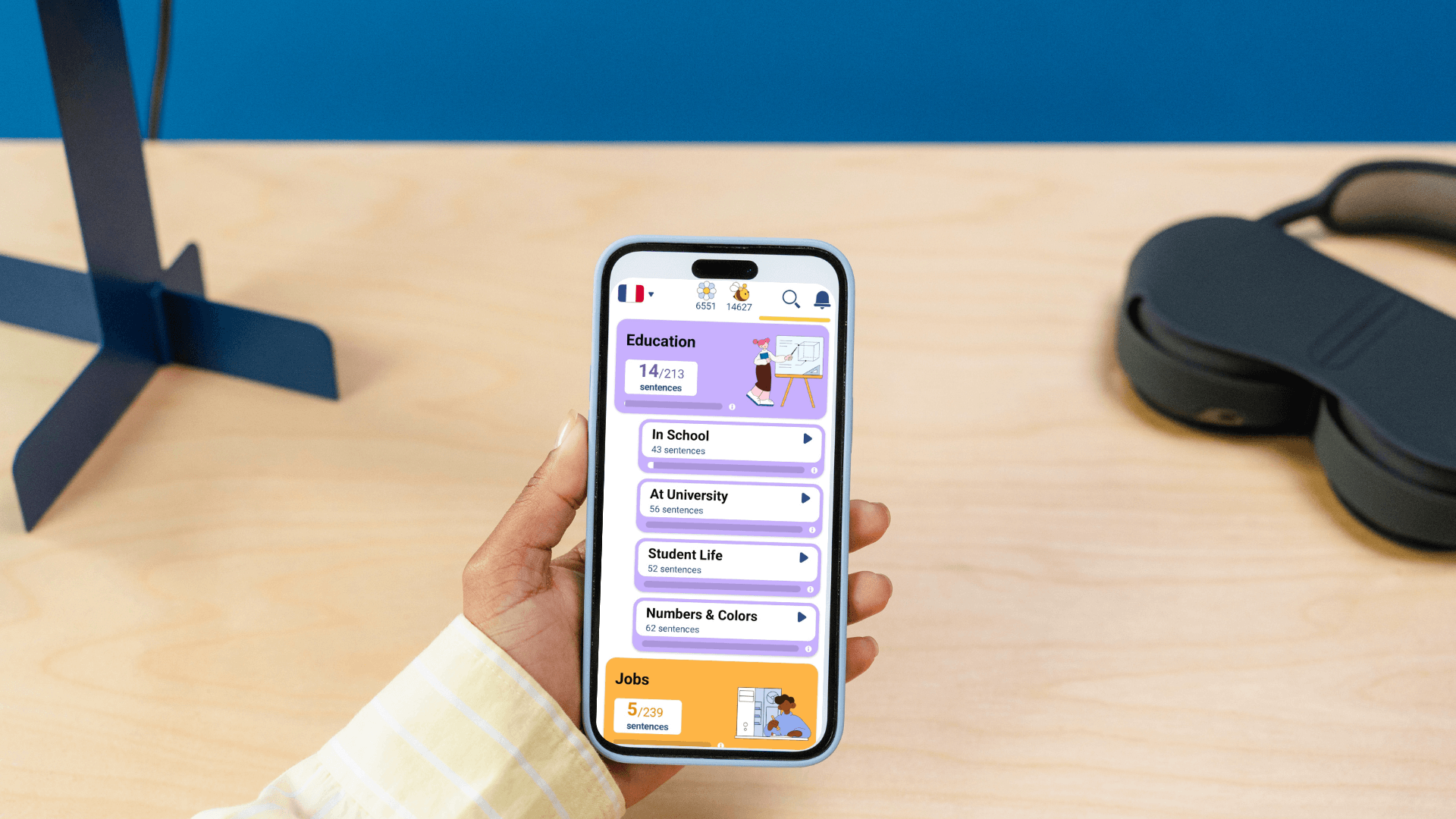When starting a new language-learning journey, learners typically want to know how challenging their new goal is. And whatever you're after - easy or difficult languages, having a general understanding of what your options are will help you get started on the right foot.
Assessing the difficulty level of a new language can be subjective. Granted, one’s ability to acquire a new language depends on a series of variables. From cognitive skills to the time devoted to learning, some languages may take longer than others and demand more effort to master.
👉Check out our article on the Top 10 Easiest Languages to Learn for English Speakers.
What Makes a Language Difficult to Learn?

A significant factor in labeling a language as difficult is comparing it to your native language. The new language is relatively easy if they belong to the same linguistic family. Mastering a foreign language from a different linguistic family is more challenging. Thus, English speakers can learn almost any Indo-European language, such as Germanic or Romance Languages. Those whose first language is English will take longer to master a tonal language, such as Vietnamese. It demands increased attention to pronunciation, as the precision of the sounds is crucial to the meaning of the words.
Languages with a different writing system than your native language will typically be considered hard to learn. For instance, English speakers who are used to the Latin alphabet find the Cyrillic alphabet quite tricky.
Difficult languages are not impossible to learn. They just require more time and effort. Moreover, mastering some of the hardest languages can be incredibly rewarding. On top of that, it can be a competitive advantage in your career, as more unusual language combinations are highly appreciated.
Groups of Difficult Languages for English Native Speakers

Before looking at specific languages, let’s quickly list the language families and groups that pose the most difficulties for English speakers. Unlike Romance and Germanic languages, the groups below have little in common with English. So, there is typically a steep learning curve associated with them.
- Sino-Tibetan Family
🔊Languages: Mandarin Chinese, Cantonese.
🛠️ Characteristics: complex writing systems and tonal pronunciation.
- Afro-Asiatic Family
🔊 Languages: Arabic, Amharic, etc.
🛠️ Characteristics: distinct scripts, extensive verb conjugations, and dialectal variation.
- Slavic Languages (part of Indo-European Languages)
🔊 Languages: Russian, Polish, Czech, Bulgarian, Serbian, etc.
🛠️ Characteristics: Complex inflectional systems and diverse phonologies.
- Uralic Languages
🛠️ Characteristics: complex case systems and agglutination (words are made up of different elements that each express a separate meaning).
Languages: Finnish, Hungarian, etc.
- Caucasian Language Families
🔊 Languages: Georgian (Kartvelian), Chechen (Northeast Caucasian), Abkhaz (Northwest Caucasian), etc.
🛠️ Characteristics: Complex phonologies and syntactic structures.
#1 Navajo
Where it’s spoken: Primarily in the Navajo Nation, within the United States.
Time to learn: around 2,200 hours.
Challenges: Navajo has a complex sound system and a verb-based structure. Being a tonal language, pitch can change the meaning of words. Very few words are borrowed from English, making it tough to learn. The numerous prefixes and suffixes alter the meaning of verbs. The language features a unique system of noun classification.
Tips to learn Navajo:
- Memorize and practice using Navajo pronouns and noun classifiers to accurately convey relationships and categories.
- Spend the first months getting used to the different tones. Intensive listening will help you sense the difference between different linguistic elements.
- Learn through verbs. Navajo verbs are complex, so the verb systems are your key to mastering the language.
- Dedicate enough time to learn the Navajo sentence structure. Start with shorter sentences and add to their complexity. Celebrate small victories to keep yourself motivated.
#2 Japanese
Where it’s spoken: Predominantly in Japan.
Time to learn: around 2,200 hours.
Challenges: Japanese uses three different writing systems - Hiragana, Katakana, and Kanji. The grammar is highly context-sensitive and includes different levels of politeness, making it particularly tough for English speakers. Social hierarchy dictates the use of honorific language. That fact, together with context-dependent grammar, makes the official language of Japan a real undertaking for English speakers.
Tips to learn Japanese:
- Study and practice using different levels of politeness in speech appropriate to various social contexts.
- Read short texts such as children’s books or simplified news articles to get comfortable with Japanese.
- Practice shadowing by repeating role-plays for everyday scenarios like ordering food or asking for directions.
#3 Arabic
Where it’s spoken: across the Middle East and North Africa.
Time to learn: Approximately 2,200 hours.
Challenges: The Arabic script is written from right to left, and the language features a complex root system. The dialects can vary significantly, complicating the learning process further. Arabic grammar demands a thorough understanding of the gender-specific forms of nouns, adjectives, and verbs, which change whether the subject is masculine or feminine. This highly gendered language takes time and effort to master.
Tips to learn Arabic:
- Master the root system. Practice identifying roots in different words and create lists of related vocabulary topics. The writing system includes plenty of three-letter roots ideal for getting started.
- To improve reading and writing, practice reading and writing the alphabet with the letters in all positions (isolated, initial, medial, and final).
- Write simple sentences following the Subject-Verb-Object order, and gradually increase the complexity by adding more details.
- As a beginner, use texts with vowel markings (harakat) to get used to the correct pronunciation.
#4 Mandarin Chinese
Where it’s spoken: mainly in China and Taiwan.
Time to learn: approximately 2,200 hours.
Challenges: Mandarin Chinese is tonal, with four tones altering the meaning of words. The use of Chinese characters instead of an alphabet per se requires learners to learn thousands of characters. Grammatical structures rely more on context rather than syntax, which is another reason English speakers find Mandarin Chinese more challenging. Mandarin grammar often qualifies the most widely spoken language in the world as the hardest language.
Tips to learn Mandarin Chinese:
- Practice drilling tones. Practice the four tones (flat, rising, falling-rising, falling) on a daily basis. This will help you develop accurate pronunciation and speak Mandarin.
- Learn and practice the correct sequence of strokes for writing Chinese characters.
- Learn popular radicals to train guess the meaning and pronunciation of new characters. Radicals are elements that make up Chinese characters.
#5 Korean
Where it’s spoken: primarily in South Korea and North Korea.
Time to learn: Around 2,200 hours.
Challenges: While Hangul, the Korean alphabet, is relatively easy, the language’s sentence structure and particles can be confusing for native English speakers. Korean grammar is also somewhat similar to Japanese, adding levels of complexity. On top of that, Korean has grammatical elements that do not exist in English and demand special attention from learners. These aspects, combined with the tonal aspects of the language, can make Korean difficult to learn.
Tips to learn Korean:
- When learning numbers, practice both the Sino-Korean and Native Korean number systems. Drill them in context to better memorize them.
- Pay attention to honorific forms. Everyday politeness is essential
- Watch Korean dramas with subtitles. Focus on popular phrases and everyday expressions. You can also listen to K-pop if you’re a fan.
- Use conjugation charts at first to help you navigate different tenses and moods. It’s a trick to avoid the frustration of building correct sentences.
Speak a new language with confidence!
Build fluency faster with FunEasyLearn — just 10 minutes a day is enough to make real progress.
#6 Hungarian
Where it’s spoken: mainly in Hungary.
Time to learn: around 1,100 hours.
Challenges: Hungarian is notable for its 18 cases and agglutinative structure. The syntax and idioms are vastly different from English, adding another layer of difficulty.
Tips to learn Hungarian:
- Write your shopping lists in Hungarian. It’s a fun way to practice vocabulary related to groceries, fruit, vegetables, etc.
- Set up a daily conjugation routine. Definite and indefinite verb conjugation drills with sentence practice will help you navigate the complicated grammar.
- Devote some time to learning how to attach possessive suffixes to nouns, as they differ from the English possessive structure.
- Study diminutive suffixes such as “-ka/-ke” or “-cska-cske” to add affection to your speech.
- Practice the order of words. The structure is more flexible than English, allowing speakers to bend the rules to emphasize different elements.
#7 Finnish
Where it’s spoken: mainly in Finland.
Time to learn: Around 1,100 hours.
Challenges: Finnish grammar includes 15 grammatical cases and a multitude of vowel harmony rules, which can be challenging for speakers of English and other languages used to minimal case usage. Finnish does not use articles (a, an, the), making it harder for English speakers to determine the definiteness of nouns. A fascinating linguistic phenomenon in Finnish is the so-called “consonant gradation,” where the consonants in the root of a word change depending on its grammatical form. For instance, "kukka" (flower) changes to "kukan" (of the flower).
Finnish uses many compound words, which can be difficult to grasp, especially for beginners.
Tips to learn Finnish:
- Master vowel harmony. Finnish words follow strict vowel harmony rules. Practice front vowels and back vowels.
- Learn postpositions. These are like prepositions but are positioned after the noun they modify, hence the name. Common ones include “kansaa” (with) and “jälkeen” (after).
- Get comfortable with the passive voice. While English speakers are typically advised against using the passive voice, it is very popular in Finnish.
#8 Polish
Where it’s spoken: primarily in Poland.
Time to learn: Around 1,100 hours.
Challenges: Polish features a seven-case system and intricate rules of verb conjugation. Pronunciation is another significant hurdle due to its consonant clusters.
Polish has seven grammatical cases, each changing the word ending of nouns, pronouns, and adjectives. Verbs are conjugated based on person, number, tense, mood, and aspect. There are also many irregular verbs to learn. Polish speakers often use diminutives, which have a different form to indicate a smaller or affectionate version.
Tips to learn Polish:
- Practice pronouncing consonant clusters.
- Drill suffixes and prefixes. Take a basic word like czytać (to read) and practice forming new words with suffixes and prefixes. Examples: przeczytać (to finish reading), czytelnia (reading room), książka (book), książeczka (little book).
- Shadow a Polish podcast, interview, or a radio or TV news broadcast. Listen to a 1-2 minute segment and repeat it to match the speaker’s pronunciation and intonation.
- Practice making sentences by writing a short review of your day in Polish. Record yourself reading it and reiterate for fluency.
#9 Russian
Where it’s spoken: predominantly in Russia and the former Soviet Union.
Time to learn: Around 1,100 hours of study.
Challenges: Russian is a Slavic language known for its complex grammar rules and Cyrillic alphabet. One of the difficulties is that some Russian letters resemble English letters but have different pronunciations. On top of that, Russian has six cases that impact nouns, pronouns, and adjectives. Each case changes the word endings, adding hours of practice. Russian verbs conjugate differently based on person, number, tense, and mood. There are also many irregular verbs. The stress of a word can change its meaning and is not always predictable. As you may assume, languages from different linguistic groups have little to no words in common. So, an English speaker will start learning the Russian vocabulary from scratch, as their native language won't be of much help.
Tips to learn Russian:
- Improve pronunciation by practicing difficult consonant clusters slower, gradually increasing the speed.
- Pay attention to soft and hard consonants.
- Write pairs of sentences using both aspects of a verb: imperfective and perfective. Example: I was reading a book - Я читал книгу (Ya chital knigu), and I finished reading the book - Я прочитал книгу (Ya prochital knigu).
- Create flashcards with nouns and practice declining them in all six cases.
#10 Turkish
Where it’s spoken: mainly in Turkey and Cyprus.
Time to Learn: Around 1,100 hours of study.
Challenges: Turkish is an agglutinative language. That means multiple affixes are attached to a root word to represent various grammatical categories. The language also has vowel harmony that doesn't exist in English, which makes it more difficult for English speakers.
The word order in Turkish is different than in English. Turkish follows a Subject-Object-Verb logic, while English uses Subject-Verb-Object. This shift in structural patterns takes time to master.
Tips to learn Turkish:
- Decompose words. Break down compound words into root and suffixes. Example: ev (house) + ler (plural) + imiz (our) +den (from).
- Practice conjugating verbs for different tenses. Use these verbs in sentences.
- Learn case endings to easily decode the meaning of a sentence. Example: kitap (book, nominative), kitabi (the book, accusative), kitaba (to the book, dative), kitapta (in the book, locative), kitaptan (from the book, ablative).
Learn Languages of Any Difficulty Level with FunEasyLearn

Learning languages is fun and easy with FunEasyLearn. Starting your learning journey is incredibly easy. Once you install the app, choose your mother tongue, then select the one or several languages you want to learn. The app currently features 42 native languages and 34 languages you can learn.
Master languages that are hard to learn with FunEasyLearn:
- Learn the difference between vowel sounds and consonants with ;
- Draw each character of a hard language such as Japanese, challenging for most English speakers;
- Turn on transcription and transliteration to facilitate reading, especially when it comes to a long word;
- Play fun games to memorize useful vocabulary and practice the right word order;
- Learn a second language, then pick up a third one;
- Use FunEasyLearn for FREE as long as you want;
- Get a premium subscription for advanced features, such as the Review Manager, Favorite Lists, the Hands-Free Mode, and more.
Final Thoughts
To successfully learn a more difficult language, English speakers need to pay more attention to the main differences between languages. The toughest languages are no match for a good learning program. With FunEasyLearn, you can build a solid vocabulary through games that are both fun and efficient.
Are you ready to learn a more challenging language?











